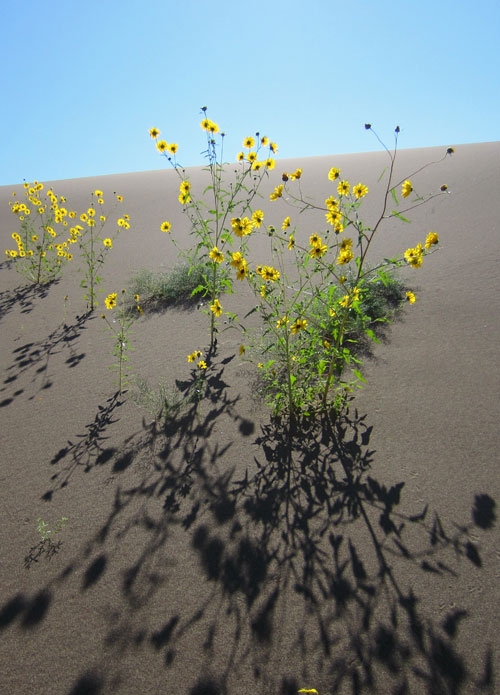Plant and animal species can adapt to a remarkable diversity of environments: from sea sides to mountain tops and from deserts to lush meadows. Populations adapted to specific environments (called ecotypes) share unique characteristics that allow them to survive where other individuals of the same species would not. These complex adaptations are often the result of the interaction between alleles at many genes, working together to modulate different phenotypic traits. How such complex allelic combinations are generated and maintained is a longstanding question in evolutionary biology. Ecotypes can generally freely hybridize with nearby, non-adapted populations; when this happens, recombination would be expected to tear apart adaptive allelic combinations, resulting in poorly adapted progeny and threatening the survival of the ecotype. This question (i.e. how complex adaptation can arise within a species in the presence of hybridization) has bothered evolutionary biologists since it was first formulated by early critics of Darwin’s work.

Figure: The prairie sunflower (Helianthus petiolaris) has repeatedly adapted to grow on sand dunes. Sand-dune-adapted populations have much larger seeds, flower later, and can use nutrients more efficiently; these adaptations are controlled by three multi-Mpb haploblocks. Photo: Kate L. Ostevik.
To answer this question, and to gain a better understanding of the genetic basis of adaptation, we characterized, and sequenced the genome of, 1500+ wild sunflower from three species. Wild sunflowers are a particularly apt species to study local adaptation, since they can be found in a variety of very different environments, like sand dunes, salt marshes, and serpentine soils, among others. We found that many adaptive traits (such as seed size, time of flowering…) and environmental variables (temperature, precipitations, soil nutrient content…) are associated not with single genes, but with very large stretches of the genome, up to more than 100 Mb (larger than many human chromosomes). These regions, which we called haploblocks, are characterized by the presence of two very distinct allelic combinations, or haplotypes. Recombination is almost completely suppressed between these two haplotypes, meaning that their allelic combinations are always inherited together, and are maintained even in the face of hybridization with non-adapted individuals.

Wild sunflower inflorescences. Photo: Marco Todesco and Natalia Bercovich
A few cases are particularly striking. In the silverleaf sunflower (Helianthus argophyllus), a 30 Mbp haploblock controls a difference in flowering time of more than 2 months between ecotypes growing in the inland of South Texas, and those growing on nearby barrier islands. In H. petiolaris, three haploblocks control many of the traits that allow ecotypes to survive on sand dunes (larger seed size, later flowering, greater nutrient use efficiency; see figure). Looking more closely for regions with similar characteristics (two large, divergent haplotypes with no, or almost no, recombination between them) we identified a total of 37 haploblocks, most of them associated with multiple adaptive traits or environmental variables. The simplest way in which recombination can be suppressed so effectively over such a large stretch of the genome are chromosomal inversions – and indeed we found large inversions associated to most of the haploblocks that we identified.
These findings closely align with evolutionary theory, which predicts that recombination modifiers would play a major role in generating and maintaining ecotypes. While a few cases of individual large inversions (or “supergenes”) controlling adaptation had been previously reported, our results highlight how this is not a sporadic event, but a powerful and widespread mechanism of adaptation. Some questions remain: chief among them, where do these haploblocks come from? The most likely explanation is that they are ancient introgressions from other species. We could confirm this in a few cases; for example, the haplotype conferring early flowering in barrier island silverleaf sunflowers was introgressed from the sister species H. annuus (common sunflower). Interestingly, this early flowering haplotype contains a functional allele of a well-known flowering time regulator (HaFT1), which is missing in the late-flowering haplotype of inland silverleaf sunflowers. For many other haploblocks, however, we could not identify the donor species. This raises the intriguing possibility that the donor is extinct, possibly replaced by the newly adapted species that stole its adaptive haploblocks.
Besides their implications on our understanding of evolution and adaptation, our observations have also practical consequences. Wild relatives are often used in crop breeding as a source of novel variation; indeed, many useful traits found in cultivated sunflower derive from its wild relative (stress resistance, plant architecture…). One common drawback of using wild material in breeding is linkage drag – large regions from the wild genome are introduced together with the useful allele, and some of the genes in these regions might have negative effects on productivity. Given enough generations of breeding, recombination can usually chip away at linkage drag, reducing or eliminating its impact. That cannot happen with haploblocks, some of which include more than a thousand genes; if recombination with the cultivated haplotype is suppressed, the extent of linkage drag will never decrease. Paradoxically, therefore, even if haploblocks could potentially act as adaptive modules, providing all the alleles needed to, for example, generate a sunflower variety with higher resistance to drought, their drawbacks could overshadow their benefits. Knowing the location and the effects of these haploblocks, in sunflower and other crops, will permit more informed breeding decisions.
Adaptive alleles stick together: behind the paper post on the Nature Ecology and Evolution community blog
Large chromosomal variants drive adaptation in sunflowers: Nature Plants News & Views
Supergenes play a larger role in evolution than previously though: UBC/Genome BC press release


































